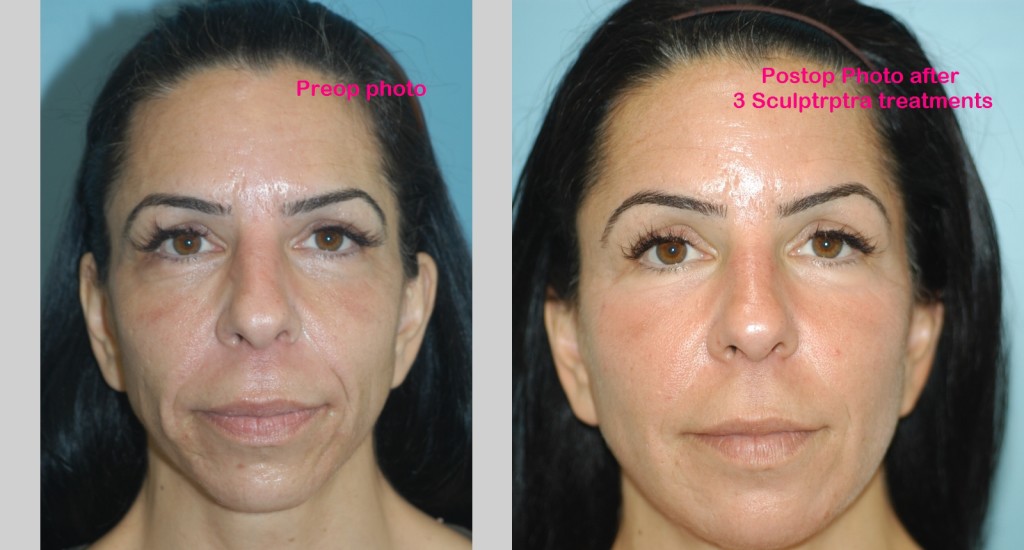Anti-Aging Fillers and Injectables: Get Most Natural Results

There’s no question: anti-aging fillers and injectables (such as Juvéderm, Botox Cosmetic and Dysport, and Sculptra Aesthetic) can take years off your face—and your look—with zero surgery and little to no downtime. Using these anti-aging fillers and injectables can delay the need for the more invasive face lift that used to be the anti-aging “treatment” of choice.
And, let’s face it, some people don’t ever want to have surgery but still want to look their best. Anti-aging fillers and injectables can be the answer.
The right anti-aging fillers and injectables for you depend on many factors—most importantly, what areas of your face need treatment to look more youthful.
In most cases, my patients get the most natural look with not one, but a combination of, anti-aging fillers and injectables.
But first, it’s helpful to understand how aging occurs—and why anti-aging fillers and injectables can help.
How We Age
One of the most visible changes that occurs to the face as we age is loss of volume. Look at any younger person and you see a full face. An older person looks shrunken and hollow. This sunken look is particularly noticeable in the cheeks, under the cheeks, and in the temples. In order to restore a youthful appearance, it’s critical to replace this lost volume.
Additionally, as we age, structural proteins located in the middle layer of skin, or dermis, gradually become thinner and less elastic. Production of the main protein, collagen, slows down. It’s collagen that acts like a scaffolding for the skin: it holds everything up and gives the skin a youthful fullness. Levels of elastin, another critical protein that gives skin its elasticity (ability to regain its normal shape after being stretched), also decrease. Losing collagen and elastin results in skin that sags. The skin also becomes more wrinkled.
Some of these facial wrinkles and folds are deeper and more obvious, such as around the mouth (the smile lines or nasolabial folds) and from the mouth to the chin (called the marionette lines).
The skin also develops hyperpigmentation or brown spots and broken capillaries (tiny red veins), particularly around the nose. Years of sun exposure can hasten this aging process (so you see these signs of aging earlier in life), though it will eventually occur on its own.
Anti-Aging Fillers and Injectables: What’s Best for You?
I offer many different types of anti-aging fillers and injectables, such as Botox and Dysport (which temporarily immobilize muscle movement to prevent wrinkles from forming), as well as hyaluronic acid fillers like Juvéderm, which can smooth out wrinkles and restore volume. I also use an injectable called Sculptra (see more on this below).
Many patients often come to my office requesting a single filler like Juvéderm or Botox and Dysport. They’ve read about it or heard about it from a friend. I’m happy that so many people are knowledgeable about what’s available. Reading up on the many options before your appointment can help us determine together what’s best for you—and your goals.
“One thing that’s important to know about me and the way I work: I look at every face from an artist’s perspective. I see the aging in each face from a different eye than from what a patient might see in the mirror.”
For example, a patient may have forehead wrinkles and request Juvéderm to correct them. But skin wrinkles are often best treated with Botox or Dysport and Retin-A (a tretinoin cream), with fillers as a last resort. And while a patient might come in complaining about her nasolabial folds (something that Juvéderm works well for), I might see that adding fullness back to her cheeks first will help create a more natural youthful look than just filling the nasolabial folds.
In fact, adding fullness back to your face will have a dramatic—yet completely natural—effect that will erase years from your look. One way to add this fullness back is with Sculptra, which looks very natural, not “done” or obvious. This is why I often use Sculptra as a “base” treatment. There are, of course, many situations in which a hyaluronic acid filler such as Juvéderm or Restylane is the product of choice. In these situations, I’ll use Sculptra in combination with these other fillers and with Botox or Dysport.
Why Use Sculptra as a “Base” Anti-Aging Treatment?
Approved by the FDA in 2009, Sculptra is made from poly-L-lactic acid, a biodegradable synthetic material that’s been safely used in dissolvable stitches for years. What I love about Sculptra is that once injected into the dermal layer, it works to gradually restore the underlying structure of skin in each of my patients by stimulating the growth of the all-important protein, collagen.
Sculptra has resulted in a very natural, refreshed look in all my patients. Your face doesn’t change overnight; instead, it gradually gets more youthful looking over the course of months with the results lasting up to two years.
“I’m a fan of Sculptra because I, myself, have Sculptra treatments every 2½ years!”
Take a look at this before and after; you’ll notice that—thanks to Sculptra—my patient’s loss of volume was restored and the condition of the skin and condition improved, refreshing her appearance. This happened gradually over nine months. The results usually last about 2 years.

I administer Sculptra to patients over the course of two to three treatments, spaced six to ten weeks apart. (I work with each patient to decide the best timetable of treatments for him/her.) Within just a few days after each injection, the poly-L-lactic acid begins to help reinforce the structure and shape of the skin, though it can take two to three months to stimulate the growth of collagen and to visibly see the full results.
The side effects of Sculptra are minimal and can include swelling and bruising at the injection site—with these subsiding within a few days of the injection.
Most of my patients are able to go back to work immediately after having Sculptra injected. Patients do need to massage the treated areas several times a day for 5 days but can otherwise return to normal activities right away.
The bottom line: To get the best, most natural-looking result for each patient, I use the anti-aging fillers and injectables that are right for each individual patient in each specific area of the face. After all, using only one product is like asking an artist to paint a landscape using only one color!
Back to blog
